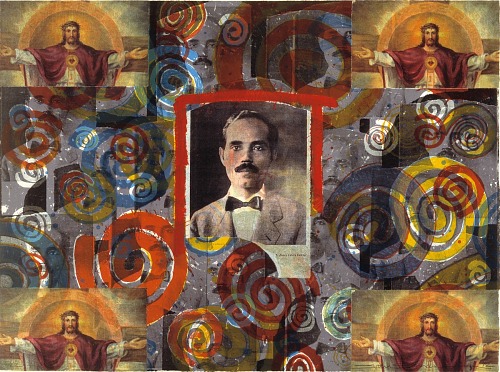Para Don Pedro by Juan Sánchez (Interpretation and Analysis)
 |
| Para Don Pedro Source: Smithsonian American Art Museum |
Nuyorican artist Juan Sánchez explores this idea in his collage Para Don Pedro. The collage centers on a photograph of Albizu Campos, which in turn is surrounded by smaller images of Christ with his arms outstretched in blessing. Albizu Campos was imprisoned for his political activities, and evidence later emerged that he had been subjected to human radiation experiments while in prison, which probably played a major role in his death shortly after his release. This series of events led many people to view him as a martyr for the cause of indepence, an idea that Sánchez references with his inclusion of Christ in the collage. Here, he draws a parallel between the two figures, comparing Albizu Campos’ sacrifice for Puerto Rico with Christ’s sacrifice for all mankind. The images of Christ may also represent Albizu Campos’ personal faith, as he was known to be a devout Catholic.
Sánchez adds another layer of meaning with a pattern of spiral designs that overlays the other images. As the Smithsonian American Art Museum points out, these spirals may reference Taino petroglyphs found in Puerto Rico. This element of the image serves to connect Albizu Campos’ work with the long history of Puerto Rican independence movements, beginning with Taino revolts against Spanish rule. The spirals may also represent an attempt to anchor Albizu Campos within the larger story of Puerto Rican culture and heritage.
Sánchez’s choice to convey this message via collage is interesting. While virtually all art historians recognize collage as a valid medium for fine art, artists who use the medium find themselves in the difficult position of relying on the creative output of others to create their own work. With collage, there is always the danger of allowing someone else’s work to overshadow your ideas as an artist. This is paired with the fear that viewers will consider the collage to be too derivative or, even worse, will consider it to be plagiarism. However, collage also offers the artist a unique opportunity to compare and contrast disparate ideas and images, something Sánchez uses to great effect in Para Don Pedro.
Disclaimer: I’m not an art historian or an expert on this topic. The above is my opinion, based on my interpretation of my foreknowledge of art and history. If I’ve done any additional research, I’ll note it above.



Comments
Post a Comment